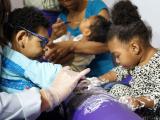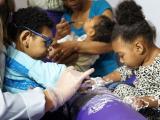The Centers for Disease Control and Prevent (CDC) today removed another Miami transmission area from its Zika travel advisory, and officials from the World Health Organization (WHO) spelled out key research priorities as it transitions efforts from a public health emergency to its regular work.
Neighborhood removed from advisory
The CDC removed a 4.5-square-mile area in North Miami Beach from its Zika travel warning, saying no local cases from the area have been reported in more than 45 days, which it said suggests the transmission risk there is no greater than for the rest of Miami-Dade County.
As when it removed Miami's Wynwood neighborhood, the initial transmission area, from its Zika travel warning in the middle of September, the CDC kept in place strong cautions for pregnant women and their partners all of Miami-Dade County. The county is still designated as a Zika cautionary area and shaded yellow on the CDC map.
With today's announcement, only two active transmission areas remain, a 1.5-square-mile area of South Miami Beach and a 1-square-mile area of the Little River neighborhood, both colored red on the map.
CDC Director Tom Frieden, MD, MPH, said in the CDC's announcement, "We understand this has been a difficult time for Miami Beach residents and tourists and thank local and state officials for their hard work to interrupt the spread of the virus in the area." He emphasized that pregnant women should not travel to the red zone and that all people living in or visiting Miami-Dade County, especially pregnant women, take steps to avoid mosquito bites and avoid sexual transmission of Zika virus.
Florida Gov. Rick Scott said today in a statement, "The DOH [department of health] now believes active transmissions of Zika are only occurring in the southern part of Miami Beach and the Little River area, and we must continue to take aggressive mosquito control measures so we can soon lift these remaining areas."
WHO research, funding priorities
WHO officials today briefed reporters on research priorities following the Nov 18 declaration that the public health emergency of international concern (PHEIC) is over.
In making the recommendation, the group's emergency committee of outside experts said unusual microcephaly clusters were the main trigger for declaring the PHEIC back in February, and that researchers have now shown a clear association between Zika and microcephaly. The WHO has said that scaling back the PHEIC allows a shift to a long-term response backed by more sustained funding.
The March of Dimes said in a statement today that regardless of how Zika is classified, it must continue to be recognized and supported as an urgent public health issue. It said though it welcomes the WHO's recommendation to develop a longer-term Zika response, "the impact of this disease on babies must be recognized as distinct among other infectious threats, meriting an escalated response."
"The Zika crisis is not over until a safe and effective vaccine is available," the March of Dimes said.
At today's media telebriefing, Peter Salama, MBBS, executive director of the WHO's Health Emergencies Program, said the agency would continue to work with countries to prevent adverse effects of the disease and to coordinate a research agenda. The WHO first unveiled a research blueprint for Zika virus in March, which was welcomed by World Health Assembly in May.
The top research priorities are, for example, detailing the natural history of the disease, identifying possible cofactors for infection, assessing birth defect risks from various Zika lineages, and vector control, Salama said.
Officials said most of the money that the WHO has received to date has come from emergency-oriented donors and that the WHO is optimistic that other funding partners can see a role for themselves in the WHO's Zika research agenda, a pattern they saw play out during the response to Ebola.
WHO has asked for $112 million to put toward Zika research but has received just over $50 million, Salama said, noting that some of the complex research questions will take several years to answer and that sustained funding for the efforts is urgently needed.
Anthony Costello, MD, the WHO's director for maternal, newborn, child, and adolescent health, said health officials anticipate 1,000 more microcephaly cases to be confirmed in Brazil among the more than 3,000 that are still under investigation.
Other developments
- The Florida Department of Health (Florida Health) yesterday reported two more local Zika cases, both involving residents of Miami-Dade County, according to its daily update on outbreak developments. Officials said investigators are still trying to determine where the individuals were exposed to the virus. The new cases lift Florida's number of local infections to 236. No new local cases were reported today.
- The CDC yesterday added the British Caribbean territory Monserrat to its Zika travel alert, following the recent detection of the island's first locally acquired Zika cases.
See also:
Nov 22 CDC press release on Miami travel advisory
Nov 22 Rick Scott statement
Nov 22 WHO media telebriefing audiofile
Nov 22 March of Dimes statement




















